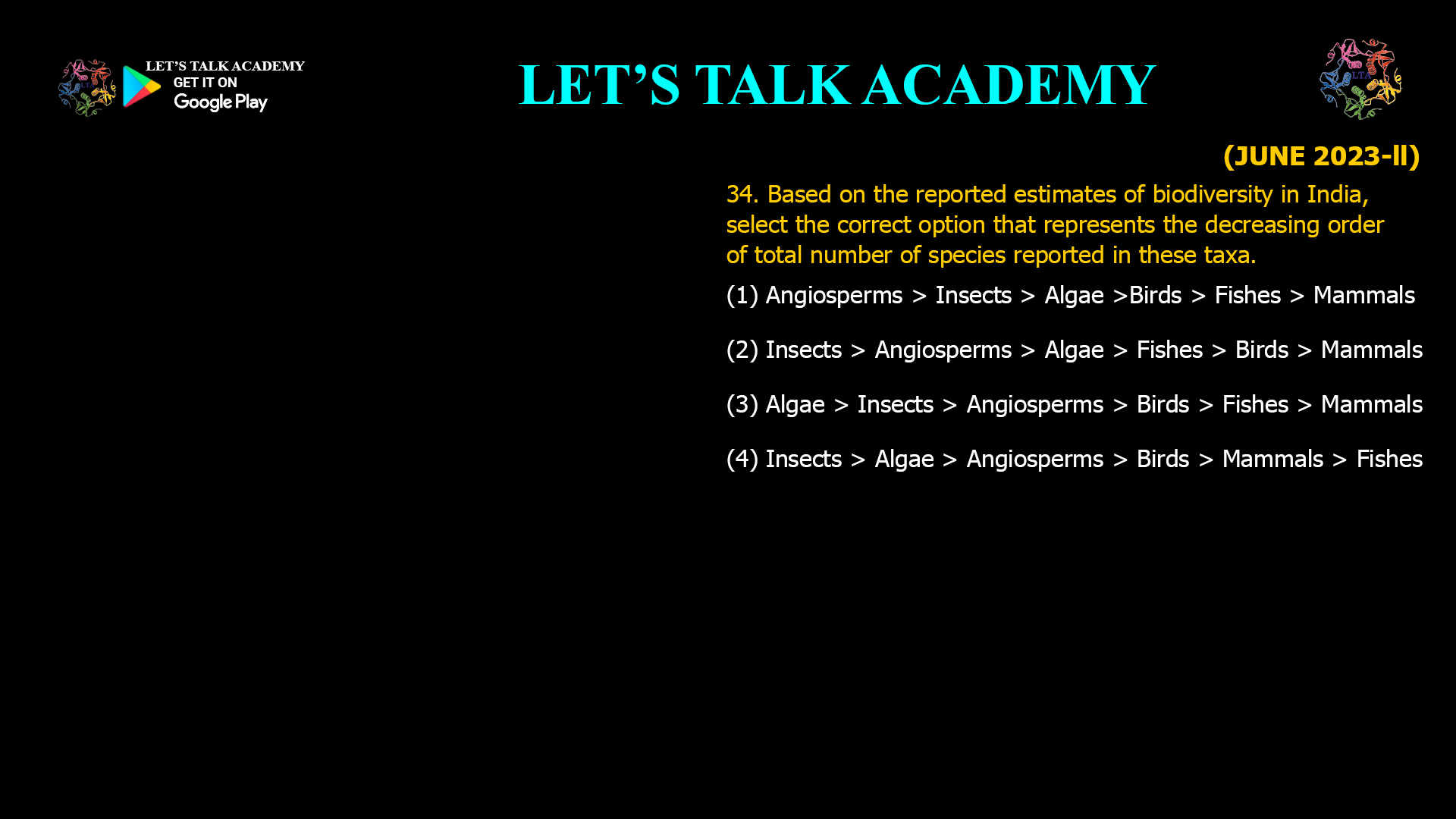- Based on the reported estimates of biodiversity in India, select the correct option that represents the decreasing order of total number of species reported in these taxa.
(1) Angiosperms > Insects > Algae >Birds > Fishes > Mammals
(2) Insects > Angiosperms > Algae > Fishes > Birds > Mammals
(3) Algae > Insects > Angiosperms > Birds > Fishes > Mammals
(4) Insects > Algae > Angiosperms > Birds > Mammals > FishesIndia is one of the world’s most biodiverse countries, home to a staggering variety of plants, animals, and microorganisms. This diversity is the result of the country’s vast range of climates, ecosystems, and geographical features, from the towering Himalayas to the lush Western Ghats and the expansive Indo-Gangetic plains. Understanding which groups of organisms are most species-rich is crucial for conservation planning and appreciating the full tapestry of life that India supports. In this article, we’ll examine the reported estimates of biodiversity in India and identify the correct decreasing order of species richness among major taxa: insects, angiosperms, algae, fishes, birds, and mammals.
The Importance of Species Richness
Species richness refers to the number of different species represented in an ecological community, landscape, or region. High species richness is often associated with ecosystem stability, resilience, and productivity. In India, the diversity of life forms is not only a source of national pride but also a foundation for ecological services, traditional knowledge, and economic development.
Major Taxa and Their Species Numbers in India
Let’s take a closer look at the major taxa in question:
1. Insects
Insects are the most diverse group of organisms on the planet, and India is no exception. The country is estimated to have over 60,000 species of insects, including butterflies, beetles, ants, bees, and more. This group dominates the animal kingdom in terms of sheer numbers and ecological roles, from pollination to decomposition.
2. Angiosperms (Flowering Plants)
India is home to approximately 18,000 species of angiosperms. These flowering plants form the backbone of terrestrial ecosystems, providing food, oxygen, and habitat for countless other organisms. The Western Ghats and Eastern Himalayas are especially rich in endemic angiosperms.
3. Algae
Algae are a diverse group of photosynthetic organisms found in aquatic and moist terrestrial environments. India has reported around 7,000 species of algae, which play critical roles in aquatic ecosystems and are important for oxygen production and as the base of many food webs.
4. Fishes
With its vast network of rivers, lakes, and coastal waters, India boasts a remarkable diversity of fishes. There are about 2,500 species of fishes found in Indian waters, including both freshwater and marine species. This makes India one of the richest countries in fish diversity in Asia.
5. Birds
India is a paradise for birdwatchers, with over 1,300 species of birds recorded. This includes a wide range of resident and migratory species, many of which are globally threatened or endemic to the region.
6. Mammals
Mammals are less numerous compared to the other groups, with India hosting about 410 species. Despite the lower numbers, India is famous for its charismatic mammals such as tigers, elephants, rhinoceroses, and leopards, as well as a rich variety of bats, rodents, and small carnivores.
Decreasing Order of Species Richness
Based on the above data and reported estimates, the correct decreasing order of total number of species reported in these taxa in India is:
Insects > Angiosperms > Algae > Fishes > Birds > Mammals
This order reflects the overwhelming dominance of insects, followed by the diversity of flowering plants, then algae, fishes, birds, and finally mammals.
Why Is This Order Important?
Understanding the relative species richness among major taxa helps in:
-
Setting Conservation Priorities: Groups with high species richness, like insects and angiosperms, require broad conservation strategies, while groups with fewer species, like mammals, often need targeted protection for individual species.
-
Ecosystem Management: Knowing which groups dominate can inform habitat management, restoration, and sustainable use practices.
-
Biodiversity Monitoring: Accurate species counts are essential for tracking changes in biodiversity due to habitat loss, climate change, and other threats.
India’s Role as a Biodiversity Hotspot
India’s position as a mega-diverse country is due to its varied topography, climate, and evolutionary history. The country is home to two of the world’s 36 biodiversity hotspots—the Western Ghats and the Eastern Himalayas. These regions are particularly rich in endemic species, especially among plants and insects.
Challenges in Estimating Species Numbers
While the above figures provide a useful overview, it’s important to note that new species are being discovered regularly, and many groups are under-studied. Insects, in particular, are likely undercounted, and the true number of species could be much higher. Advances in molecular taxonomy and citizen science are helping to fill these gaps.
Conservation Implications
Protecting India’s biodiversity requires a multi-faceted approach:
-
Habitat Protection: Preserving forests, wetlands, grasslands, and aquatic systems is crucial for safeguarding the habitats of all taxa.
-
Species-Specific Action: Endangered species, especially among mammals and birds, need focused conservation programs.
-
Research and Monitoring: Continued investment in taxonomy, ecology, and biodiversity monitoring is essential to understand and protect India’s natural heritage.
Conclusion
India’s biodiversity is a treasure trove of life, with insects leading the way in species richness, followed by angiosperms, algae, fishes, birds, and mammals. Recognizing the correct order of species diversity among these taxa is not just an academic exercise—it’s a foundation for effective conservation and sustainable development. As India continues to grow and develop, safeguarding its natural wealth will be critical for future generations.
Correct answer:
(2) Insects > Angiosperms > Algae > Fishes > Birds > Mammals -




1 Comment
Kajal
November 5, 2025Option 2